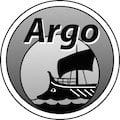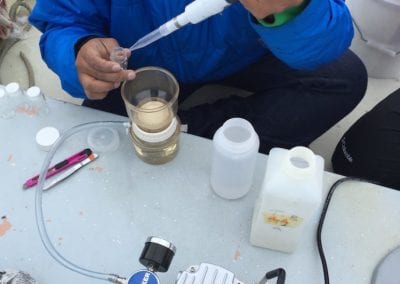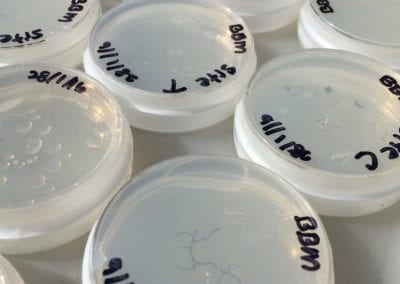SCIENCE EXPEDITIONS
Our research vessel Australis provides a flexible, relatively low-cost research platform and logistical support to National Antarctic Programs, Institutions, Laboratories and other peer-reviewed projects.
Each year for nearly two decades, our science-support capability has grown and is now a significant part of our operations.
Click here to enquire today about a science or research expedition.
______
Below are some of the projects to receive our support:
Australian Antarctic Division
For more than a decade we’ve played an integral role supporting the pioneering research into seabird mortality by Dr Graham Robertson, seabird ecologist with the Australian Antarctic Division. As a result of this work, Graham has recently been awarded a prestigious Pew Marine Conservation Fellowship. Congratulations Graham!
View project details at: AAD Research
Malaysian Antarctic Research Program
When the Malaysian Antarctic Research Program was looking for cost-effective logistical support for their inaugural dedicated Antarctic research cruise, they chose Ocean Expeditions. The main research focus was to determine the effect that Antarctic climate change has on the lives and economies of those living in the tropics. The projects didn’t require the support of icebreakers or other large vessels and the results have the Malaysian team keen to return in the following seasons.
View project details at: UTM Antarctic Research
Turkish Antarctic Research Program
The Turkish Antarctic Research Program has been active in Antarctica since the 1960’s, however had never put together their own research voyage… until now! In 2017 it begun, and with the support of the R/V Australis, the expedition included physical sampling of planktons, algae, benthos, distributed over a distance of 2000 nautical miles along the West Antarctic Peninsula. During the expedition, surveying and mapping on land, approximately 2 (two) million square meters of location, a number of points for satellite validation and ground-truthing as well as around 1 million square meters of bathymetric surveying at the adjoining locations were conducted. Bathymetric surveys were jointly conducted by the TAE- I members and the crew of the R/V Australis. The expedition reached until 67°56’ South along the Peninsula..
View project details at: PolRec Turkish Antarctic Research
Belgian Antarctic Research Voyage
In the framework of the RECTO project funded by the Belgian Science Policy Office, the expedition aims at carrying out a biodiversity census in the Western Antarctic Peninsula in March 2018, and to test-case the potential for an agile sampling platform R/V Australis. The expedition bears a strong historic link to the first scientific expedition to overwinter in Antarctica in 1897-99 recording the first intertidal biodiversity data, 120 years ago. This historic expedition was led by Adrien de Gerlache, onboard the RV Belgica.
View project details at: Belgica 120 Antarctic Research voyage
View project details at: Recto / vERSO projects
Leopard Seal Acoustics
R/V Australis supported the acoustic work of Marlee Tucker from the Rogers / Mammal lab at University of New South Whales – UNSW to both record and play back calls to calculate density of seals present on the antarctic peninsula. The calls recorded can be used to calculate the density of seals present and related back to environmental features that are important to the seals, such as key foraging areas.
View project details at: Marlee Tucker – fieldwork
Scientific papers written as a result of data collected onboard
Citations since 2003
Institutions and laboratories supported
National Antarctic Programs supported
LIST OF SCIENTIFIC PAPERS
This is a list of scientific papers that have been published as a result of science done onboard one of our vessels:
- Mohd Shahrul Mohd Nadzir, Matthew Ashfold, Mhd Firoz Khan, Andrew D. Robinson, Conor Bolas, Mohd Talib Latif, Ben M. Wallis, Haris hasrizal, ZamZam Tuah, Goh Thian Lai, Juneng Liew, Fatimah Ahamad, Royston Uning, Azizan Abu Samah, Iq Mead and Neil R. P Harris. The temporal and spatial distribution of surface ozone in the marine boundary layer during Malaysian Antarctic Scientific Expedition Cruise’16 (MASEC’16).
- Raimilla, V., Suazo, C. G., Robertson, G., & Rau, J. R. (2014). Observations suggesting cooperative breeding by Striated Caracaras (Phalcoboenus australis). Journal of Raptor Research, 48(2), 189-191.
- Robertson, Graham, Carlos Moreno, Javier A. Arata, Steven G. Candy, Kieran Lawton, Jose Valencia, Barbara Wienecke, Roger Kirkwood, Phil Taylor, and Cristián G. Suazo. “Black-browed albatross numbers in Chile increase in response to reduced mortality in fisheries.” Biological Conservation 169 (2014): 319-333.
- Acevedo, J., Haro, D., Dalla Rosa, L., Aguayo-Lobo, A., Hucke-Gaete, R., Secchi, E., … & Pastene, L. A. (2013). Evidence of spatial structuring of eastern South Pacific humpback whale feeding grounds. Endangered Species Research, 22(1), 33-38.
- Raimilla, V. (2012). Primer registro documentado del Salteador Pardo Stercorarius Antarticus (Lesson, 1831)(Stercorariidae) para las costas del Pacífico desde el Archipiélago Diego Ramírez, Sur de Chile. In Anales del Instituto de la Patagonia (Vol. 40, No. 2, pp. 151-154). Universidad de Magallanes.
- Acevedo, J., O’Grady, M., & Wallis, B. (2012). Avistamiento de la ballena común en el Pacífico Sur Oriental Subtropical:¿ Una potencial área de reproducción?. Revista de biología marina y oceanografía, 47(3), 559-563.
- Aguayo-Lobo, Anelio, Jorge Acevedo R, José Luis Brito, Paola Acuña G, Manuela Bassoi, Eduardo R Secchi, and Luciano Dalla Rosa. “”Presence of the leopard seal, Hydrurga leptonyx (de Blaincille, 1820), on the coast of Chile: an example of the Antarctica-south America connection in the marine enviroment.” Oecologia Australis 15, no. 1 (2011): 69-85.
- Acevedo, J., Matus, R., Droguett, D., Vila, A., Aguayo-Lobo, A., & Torres, D. (2011). Vagrant Antarctic fur seals, Arctocephalus gazella, in southern Chile. Polar Biology, 34(6), 939-943.
- Acevedo, J., Olavarría, C., Plana, J., Aguayo-Lobo, A., Larrea, A., & Pastene, L. A. (2011). Occurrence of dwarf minke whales (Balaenoptera acutorostrata subsp.) around the Antarctic Peninsula. Polar biology, 34(2), 313-318.
- Kirkwood, R., Lawton, K., Moreno, C., Valencia, J., Schlatter, R., & Robertson, G. (2007). Estimates of southern rockhopper and macaroni penguin numbers at the Ildefonso and Diego Ramírez Archipelagos, Chile, using quadrat and distance-sampling techniques. Waterbirds, 30(2), 259-267.
- Robertson, G., Moreno, C. A., Lawton, K., Kirkwood, R., & Valencia, J. (2008). Comparison of census methods for black-browed albatrosses breeding at the Ildefonso Archipelago, Chile. Polar Biology, 31(2), 153-162.
- Robertson, G., Moreno, C. A., Lawton, K., Arata, J., Valencia, J., & Kirkwood, R. (2007). An estimate of the population sizes of Black-browed (Thalassarche melanophrys) and Grey-headed (T. chrysostoma) Albatrosses breeding in the Diego Ramírez Archipelago, Chile. Emu, 107(3), 239-244.
- Lawton, K., Robertson, G., Kirkwood, R., Valencia, J., Schlatter, R., & Smith, D. (2006). An estimate of population sizes of burrowing seabirds at the Diego Ramirez archipelago, Chile, using distance sampling and burrow-scoping. Polar Biology, 29(3), 229-238.
- Lawton, K., Robertson, G., Valencia, J., Wienecke, B., & Kirkwood, R. (2003). The status of Black‐browed Albatrosses Thalassarche melanophrys at Diego de Almagro Island, Chile. Ibis, 145(3), 502-505.
R/V ‘Australis’ – Scientific Installations
| Instruments | CTD (Conductivity, Temperature, Depth) profiler + options Rosette Sampler / Niskin Water Sampler Acoustic release |
| Labs | Wet lab / Dry lab / Computer lab (Please request in advance) |
| Cold storage capabilities | Freezer 390 Lt at −18 °C Refrigerator largest 450 Lt at 4 °C |
| Water supply | Desalinated water |
| Forecasting | Wind speed and direction Air temperature Barometric pressure Relative humidity Precipitation Cloud cover Snow fall Sea surface temperature Sea state Swell direction height & whitecap probability |
| Weather imagery | NOAA satellite live weather imagery receiving capability world over. Accurate coastline overlay on all pictures. Thermal readout/image colouring. Integrated Ocean depth 2 nml intervals & land elevation display. Overlay of wind information. |
| Ice imagery | ENVISAT satellite real time ice extent imagery Mapping ice sheet characteristics and dynamics. Mapping sea ice distribution and dynamics. Spatial resolution of 150m Accurate coastline overlay overlay on all pictures. 100km swath. GIS enabled (GPS overlay for vessel to navigate on directly. |
| Cartography | Customised topographic cartography for specific Mountaineering or scientific expedition needs. |
| SWATH imagery | Customised satellite SWATH to order on location & real time satellite imagery |
R/V ‘Australis’ – Hydrographic Installations
| Winch | Max line pull: 680 Kg Max line speed: 118 mt/min Motor: Hydraulic 15″ Cuin 104-1434 Char-Lynn Discs: 355 mm Stainless Steel Splitter: Bronze (Please request in advance) |
| Rope | 600 M x 8 mm Dyneema double braid (SWL) 2800 kg |
| Sidescan Sonar | Beam width 95 M Depth 30 M 2D & 3D bathymetric mapping Real time display & recording |
| DualBeam Eco sounder | Depth 450 M Frequency 200/83/455 kHz 2D & 3D bathymetric mapping Real time display & recording |
| SingleBeam Eco sounder | Commercial Furuno Ecosounder FCV-295 Commercial Furuno Transducer 200/50 kHz 2D & 3D bathymetric mapping Real time display & recording |
| A-frame | Stern and side (Please request in advance) |
| Wet lab / dry lab | Stainless steel tray 2M x 600mm x 35mm (Please request in advance) |
| Bottom, Sediment, Benthic Grab sampler – Van Veen Grab | Sample volume: 5 Lt (Please request in advance) Sample area: 150mm x 290mm Material: Stainless steel Weight: 20kg |

























































